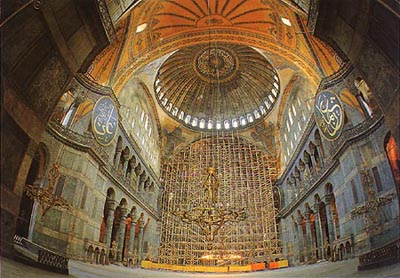Hagia Sophia, One of the seven wonders of the Medevil World, the Hagia Sophia was built in 537 AD. In Greek, Hagia Sophia means ‘Holy Wisdom’, is home to the orthodox and Greek Catholics. This was the world’s largest cathedral until the Seville Cathedral was completed a thousand years later, in 1520. Once a patriarchal bascilica followed by a mosque, the Hagia Sophia stands today as a museum in Istanbul, Turkey. The Hagia Sophia as we see it today was built subsequent to the fall of two churches which once stood there. The first of which was built in the first millennium as a pagan temple in 360 AD. However, it was destroyed when Archbishop John Chrysostom was sent into exile by Emperor Arcadius for criticizing the empress. Nothing remains of that church today. The church was rebuilt by Emperor Theodosius II and designed by the architect Rufinos in 415 AD but was similarly destroyed. Marble block remainders of this Church have been recovered and survive to this day. These two churches were primarily used as the main churches of the Byzantine Empire. The final construction as we see today was initiated by Emperor Justinian in 532 AD.
The exquisite architecture composing the cathedral, designed by Isidor of Miletus and Anthemius of Tralles, led it to being the epitome of the Byzantine architecture. The Hagia Sophia, most well-known for its tremendously large dome with a diameter of 110 feet and 210 feet above the ground, required innovation of new ideas of providing a basis for the dome. This was accomplished using 4 piers with a base of 118 yards squared. The significance of the dome was the vault leading to the heavens. As a whole, the size of the church is 260 x 270 feet. A beautiful collection of relics occupied the walls of the church including a silver iconostasis, a wall of religious paintings, of 50 feet in height
The Hagia Sophia served as a cathedral church for the Patriarch of Constantinople for over a thousand years, during which it was sought to be the ‘mother church of the Christian East’. However, the cathedral was transformed into a mosque on May 29, 1453 by the Turkish Ottoman Sultan Mehmet. This was a result of the poor conditions undergone by the cathedral including missing doors. As a result, the transition demanded clean-up removal of the bells, iconostasis, altar and plastering of the mosaics. It was renamed to the Ayasofya Mosque. In addition, a mihrab, minbar, and 4 minarets were built. In 1935, the Turkish head-of-State, Mustafa Kemal converted the mosque to a museum as it exists today. During the course of the period when the Ayasofya was a mosque, it was the prominent in Istanbul. Many mosques built by the Ottomans used its modeling and architecture. Examples of these are the Sultan Ahmad Mosque, the Suleymaniye Mosque, and the Rustem Pasha Mosque. However, with time the mosque required additional structural support. One of the world’s first earthquake engineers, an Ottoman architect, Sinan, accomplished this task. More so, Sinan engineered two additional minarets in the western side of the mosque.





















+%E2%80%93+Discover+Grand+Canyon+in+Northern+Arizona+1.jpg)




0 comments:
Post a Comment